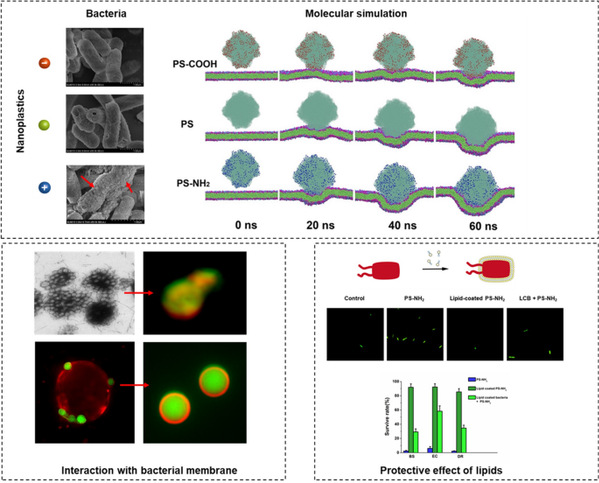As a fundamental material, plastics not only have profound effects on the development of modern industry but also penetrate into every aspect of people’s lives. However, they are also the culprit of severe pollution globally.
Large plastic debris can be fragmented into microplastics (1 μm to 5 mm in size), submicroplastics (100 nm to 1 μm in size) and further decomposed into nanoplastics (1–100 nm in size) due to sunlight radiation and slow biodegradation. The nanoplastics can translocate into cells and accumulate in human tissues, those constituting a grave health hazard.
On the other hand, bacteria, which are ubiquitously distributed, play an indispensable role in the ecosystem cycle. Therefore, understanding how nanoplastics interact with bacterial cell membrane is of vital significance to grasping their uptake processes as well as analyzing their relevant risks in ecosystems and human microflora.
On April 16, Prof. ZHOU Ruhong, Prof. HUA Yuejin and Prof. TIAN Bing from the Zhejiang University College of Life Sciences published an article entitled “Distinct lipid membrane interaction and uptake of differentially charged nanoplastics in bacteria” in the Journal of Nanobiotechnology. This work was the first to reveal the detailed interaction between differentially charged nanoplastics and bacteria.
Graphical abstract
The research demonstrated that nanoplastics entered bacteria depending on the surface charges and the structural features of membranes. Positively charged polystyrene nanoplastics (PS-NH2, 80 nm) could efficiently translocate across cell membranes, while negatively charged PS (PS-COOH) and neutral PS showed virtually no efficacy in translocation. To better understand the mechanism underlying the translocation of nanoplastics into bacterial cells, the researchers performed molecular dynamics simulations to study the detailed interactions of differentially charged PS nanoplastics with the cell membrane. Their findings demonstrated that the insertion depth of nanoplastics increased in the order of PS-NH2 > PS > PS-COOH. Moreover, PS-NH2 displayed more favorable electrostatic interactions with bacterial membranes and was subjected to internalization through membrane penetration.
PS-NH2 also conveyed more cell stress by inducing a higher level of the reactive oxygen species (ROS), which eventually led to damages and destructions to bacteria. Interestingly, the subsequently released membrane lipid-coated nanoplastics were almost nontoxic to cells, and likewise, stealthy bacteria wrapped up with artificial lipid layers became less sensitive to the positively charged nanoplastics, thereby illustrating that the membrane lipid could shield the strong interaction between the positively charged nanoplastics and cells.
This work opens up a new avenue for the risk assessment and bioremediation of nanoplastics.
Prof. Zhou RuHong is also the Dean of SIAS -- Shanghai Insititute for Advanced Study of Zhejiang University.


